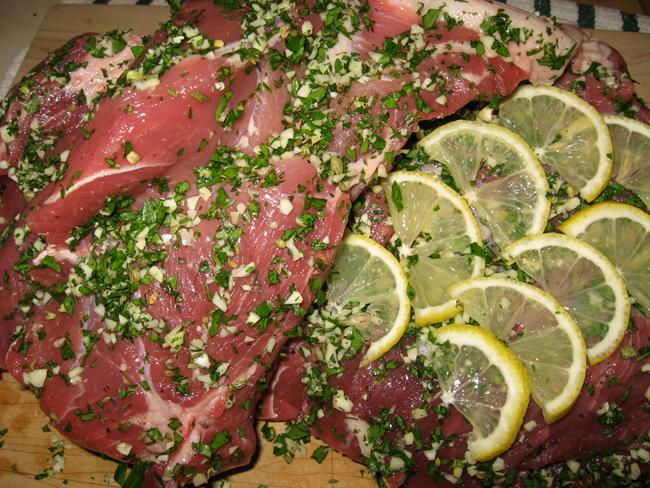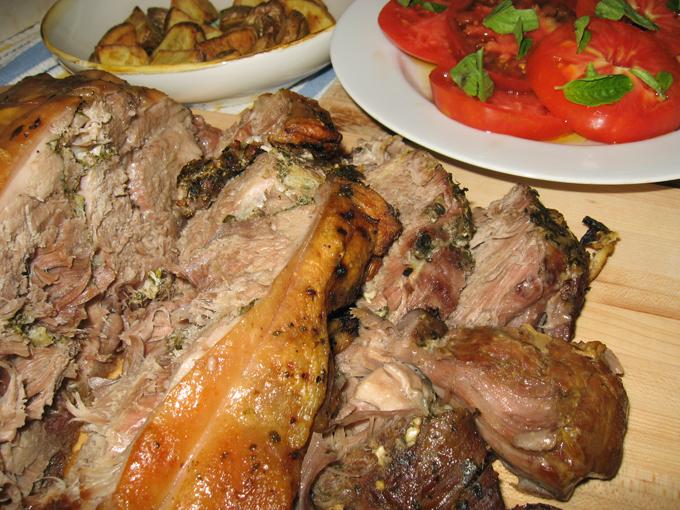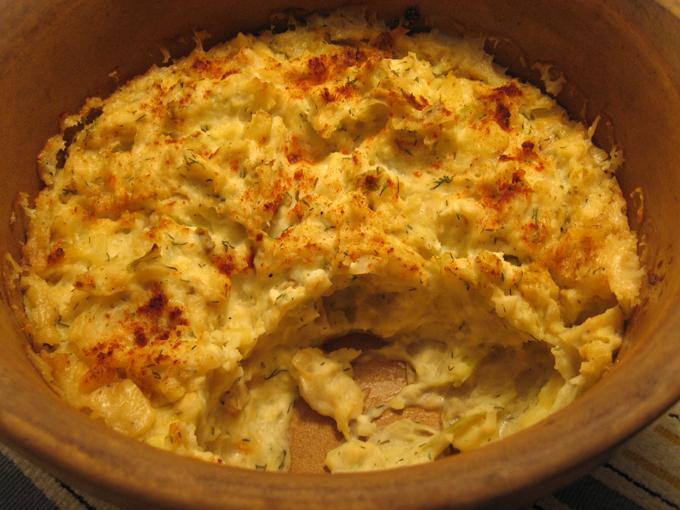-
Posts
1,729 -
Joined
-
Last visited
Content Type
Profiles
Forums
Store
Help Articles
Everything posted by djyee100
-
I wonder about the sugar in Ripert's recipe. I wouldn't expect it to hurt the preserved lemons. It does introduce sweetness in the lemons, though, and for many dishes with preserved lemons, you probably wouldn't want that extra sweetness from the get-go. You can always add a little sugar to a dish if it needs it, but if you're automatically adding sugar with another ingredient, you can't get that sweetness out afterwards--you can only modify it. Make sense? The traditional salted lemons (like Wolfert's recipe) will give you the cleanest lemon flavor. That's the method I prefer. I learned this rule of thumb: 1 Tablespoon of kosher salt per lemon. Also, I always buy some extra lemons for the juice needed to top off the jar. Depending on my mood, I will layer in some spices: cinnamon sticks, coriander seeds, black peppercorns, whole cloves, bay leaves, whole allspice. It's something to play around with if you feel like it. I've been told Meyer lemons make great preserved lemons. I'd like to try that myself this winter. I've also made this quickie version of preserved lemons, where the lemons are boiled and brined. The lemons are ready in a week. They have good flavor, but not the intensity of flavor of the traditional salted lemons. If you're pressed for time, this method comes in handy. http://www.myrecipes.com/recipe/preserved-lemons-10000000600612/ ETA: The Washington Post recipe is more of my idea of a confit. This one is an oil pickle, and a condiment. When I hear "confit" I think of oil, and sometimes sugar. It tastes good right out of the jar. None of these things are true of the traditional salt-cured preserved lemons, which are meant to be combined with other ingredients, and often cooked. If you see "preserved lemon" in a recipe's ingredients list, it means the salt-cured preserved lemons. I was reading the comments in Ruhlman's blog. Sometimes too many ideas spoil the broth. Excuse me, the preserved lemons. A traditional recipe like Wolfert's is the most safe and reliable. Lemons are extremely acidic, so they preserve well, and salt is...salt. Use a mason jar (no earthenware jars, which can absorb moisture if they're unsealed), use enough salt and lemon juice, pack those lemons down hard, so that they're packed solid, and you should be OK. I'm wary of sugar or water in the mix--those ingredients can be mold-inducing.
-
I once brought a salad of roasted beets, oranges, toasted walnuts, and romaine lettuce to a holiday potluck. I kept each ingredient and the dressing in separate containers. Just before service, I arranged the ingredients attractively on a platter, and drizzled on the dressing. I didn't toss the salad because the beets would have bled color over everything else. The salad tossed itself as people took portions and moved things around. People liked it and ate it up. Now, this was a group that I knew would eat beets. But you can substitute avocado slices in the same salad, although you'll have to prep the avocado right before service and sprinkle the slices with lemon juice so they don't brown. I started with Joanne Weir's recipe for Beet, Orange, and Walnut Salad in her Tapas to Meze cookbook. Very similar to this one, which appears to be a variation: http://www.food52.com/recipes/9473_beet_orange_olive_and_walnut_salad No olives or preserved lemons in my salad, no walnut oil either (I didn't have any around, so I subbed olive oil). I suggest roasting the beets in a metal pan with a little water, covered with foil. Without the water, the beets seemed to take forever to cook. Also, if you roast things in a stoneware baking dish, the dish might crack--I learned this the hard way--so that's why I suggest a metal pan. The salad is eyecatching on the buffet table, with the crimson beets and the oranges. It looks even better than the pic on the webpage.
-
You might want to ask the butcher to split the head and remove the brain, if you are making headcheese. Also to ask the butcher to split the feet for easier handling. Meanwhile, I came across this recipe for country pate, using fresh pork liver, while flipping through Susan Loomis' Cooking At Home On Rue Tatin. http://www.epicurious.com/recipes/food/views/Pate-de-Campagne-105269
-
I have the wrong pigs or I'm doing this wrong, but I can never get any meat off trotters. I keep them for stock. What recipes do you use? There's not that much meat in pig's feet anyway. Mostly it's gelatinous, fatty skin. I have fond memories of it from my childhood, when my parents stewed it Asian-style. It was very warming for those New England winters. The sauce in this recipe is similar to how my parents cooked pig's feet, although they never bothered with niceties like mushrooms or eggs. I remember the base of garlic, ginger, soy, & five spice powder. http://sunflower-recipes.blogspot.com/2009/10/southern-taiwanese-stewed-pork-rice.html The last time I cooked with a pig's foot, I tossed it into a braised beef dish to enrich the sauce. Before service I removed the bones and the skin. This recipe from the Zuni Cafe cookbook calls for a pig's foot if you use chicken stock instead of beef stock, but I'm pretty sure I used beef stock and a pig's foot. Is there such a thing as a beef stew that is too rich? http://kayaksoup.blogspot.com/2006/12/zuni-cafe-brasato.html High on my list for this winter is Gratin of Pig's Foot with Vin Jaune and Comte Cheese, from Paula Wolfert's Mediterranean Clay Pot Cooking. The first page of the recipe is available on Googlebooks. After that, you can figure out how to make a gratin. Here, page 178: http://books.google.com/books?id=HT6D2fD4qIwC&pg=PA178&lpg=PA178&dq=gratin+of+pig's+foot+with+vin+jaune+and+comte+cheese&source=bl&ots=GL-wfphVNj&sig=chgojZXT-FS4ITVoHZ4_pkj4We4&hl=en&ei=O6S4Tpu-GaXniALB35TmBA&sa=X&oi=book_result&ct=result&resnum=1&sqi=2&ved=0CBoQ6AEwAA#v=onepage&q&f=false
-
I always bake Alice Medrich's recipe for lemon bars. They're very lemon-y. An adapted recipe on this blog, the bars made into a tart: http://blueridgebaker.blogspot.com/2010/01/very-tangy-lemon-bars.html A variation on the lemon bars, which I like as much as the classic lemon bars. I suggest puree-ing the apricot jam so that the filling is smooth. Apricot Lemon Hazelnut Bars: http://dessertfirstgirl.com/2011/06/apricot-lemon-hazelnut-bars.html#more-904
-
If you get some pork shoulder with skin on it, you can make Pernil, as from this recently revived EGullet thread: I'll vote for headcheese, also. Just make sure hubby doesn't see you cooking it. If you put the finished headcheese in front of him, it will be a delicious, interesting pate or terrine with little crunchy bits (from cartilage, including the ears and snout). I like the roasted pork liver that is sometimes available in Chinatown. It's marinated in an Asian sauce, then roasted and sliced (think of the Chinese roast duck treatment). I've always eaten it at room temp as a side dish with other items and steamed rice or noodles. Some people say the liver-y flavor is too strong. Maybe it's an acquired taste. You're cooking the pig's feet, aren't you? The cold weather is perfect for making something hearty with pig's feet.
-
When I baked a Shaker lemon pie, the pith tasted pretty bitter to me. With all due respect, some people love Shaker lemon pie, and others just hate it. It's the bitterness from the pith. Some people are more sensitive about it than others. The last lemon tart I baked came from Lori Longbotham's Luscious Lemon Desserts, and I can recommend it. It's available on Googlebooks, page 51. A picture of the tart is on the cover of the book. The tart presents better with a little confectioners' sugar sifted onto it. On Googlebooks, page 51: http://books.google.com/books?id=ZymiZw6hW5AC&printsec=frontcover&dq=longbotham+luscious+lemon+desserts&hl=en&ei=k8O1Tu61DKjniAL52Ph1&sa=X&oi=book_result&ct=result&resnum=1&ved=0CDYQ6AEwAA#v=onepage&q=lemon%20tart&f=false While surfing around I came across this recipe for lemon tart on David Lebovitz's website. It's basically lemon curd in a tart shell. Although I haven't tried it, I've found DL's recipes to be reliable. Here: http://www.davidlebovitz.com/2009/05/tart-au-citron-french-lemon-tart/ good luck!
-
Omigod. He carved teeth into a roasted pepper. LOL. I liked the ghost octopus too.
-
Is the recipe like this one? http://www.cookography.com/2008/rustic-italian-bread As long as you do a good job of hand-kneading, I foresee no problem. If you use a bread flour with high protein content, the dough will be harder to knead, but you can still do it with good results.
-
Mjx, the only direction from here is up.
-
If the meat is tasteless, I'd give up on it. There's nothing you can do about that. Tasteless is tasteless, whether the meat is tender or not. The sauce could be your base for a rich vegetable stew or gratin.
-
I had to dig this one out of the memory database, since I haven't cooked it in ages. A casserole of all-beef hot dogs, sauerkraut with sauteed onions, raisins, and sliced boiled potatoes with butter. Some broth to moisten, a sprinkling of Swiss or Gouda cheese on top, then the casserole was baked in the oven until heated through and bubbling. I started with a recipe in Gourmet mag and played around with it. It's best made with knockwurst, but one day I didn't have any knockwurst so I subbed some all-beef hot dogs, and the casserole still tasted good.
-
Was the browning step difficult? Or was it something else?
-
I was curious, too, so I scouted around the web. Try reading this passage by Olney in The French Menu Cookbook, page 161, his explication of browning for lamb stew: http://books.google.com/books?id=jNWo_bhPvscC&pg=PA161&lpg=PA161&dq=richard+olney+brown+onions+enamel&source=bl&ots=wvGXnCvUCG&sig=e_tyZgdYl-D0qappGOp0po7sh7k&hl=en&ei=BDKmTq37BoTiiAKBponQDQ&sa=X&oi=book_result&ct=result&resnum=1&sqi=2&ved=0CBoQ6AEwAA#v=onepage&q&f=false He makes a distinction between a heavy iron skillet and an enameled ironware casserole. Perhaps he has problems with the high sides of the casserole dish? More moisture will evaporate off faster in a conventional skillet for browning. (Of course, then you have an extra pan to wash. Who washed Richard's dishes for him?) BTW, Olney first browns the onions, removes them from the pan, browns the meat, and returns the onions to the pan. That does make sense to get around the burning fond problem.
-
Lucky you. Since hickory nuts are supposed to taste like pecans, I suppose you could sub them in any recipe calling for pecans. The Shakers cooked with hickory nuts (not to mention other nuts and berries that were common when this country was young). You could check out some Shaker cookbooks and recipes.
-
This may be obvious, but how high is your heat turned up? Browning the meat requires high heat, but not browning the onions. Try browning the onions over very moderate heat. Onions contain a lot of water, and over moderate heat they won't burn up. Their moisture should keep the fond from burning also. Cast iron retains heat. If your pan is too hot even when you lower the heat on your stove, take the pan off the burner for a minute.
-
You could make green tomato jam. Rosetta Costantino has a recipe for Green Tomato Jam (Marmellata di Pomodori Verdi) in her cookbook, My Calabria. It's available on Googlebooks, page 275. Here: http://books.google.com/books?id=86R77RdzTj8C&pg=PA275&lpg=PA275&dq=rosetta+costantino+green+tomato+jam&source=bl&ots=vXZnKGHxb3&sig=qHqEQQVGVOTfWBYsv891NN0ACuY&hl=en&ei=MX2kTuLvOoeiiQK1hJWnAQ&sa=X&oi=book_result&ct=result&resnum=1&sqi=2&ved=0CBoQ6AEwAA#v=onepage&q&f=false I tried some of the jam recently, and I thought it was great. It's sweet-tart and versatile. You can use it in a jam tart, or serve it alongside cheeses. Someone told me she likes to serve it with manchego cheese. An adapted version of the green tomato jam recipe, and other green tomato recipes, are here. Keep scrolling. http://forums.finecooking.com/node/33229
-
An afterthought. David Lebovitz posted this unusual, fuss-free recipe for tart pastry on his blog. I've never tried it. But now that I've remembered it, I should. http://www.davidlebovitz.com/2009/05/french-tart-dough-a-la-francaise/ EGullet thread about it here:
-
I suggest trying out cookie-like or shortbread-like crusts. They are very forgiving and you don't have to roll them out--you just press the dough into the pan. You have some room for improvisation with these crusts, too, like adding chopped nuts or other flavorings to them. This Chocolate Walnut Tart from Georgeanne Brennan is the easiest tart I know of: http://articles.sfgate.com/2001-09-05/food/17617581_1_dinner-table-olives-southern-california/10 Do you have the French tart pan, metal with all those little ridges? Like this: http://www.surlatable.com/product/PRO-17186/Matfer-Tinned-Steel-Tart-Pans They're my favorite tart pan, but they can be a b---h to clean if you have to scrape out pastry bits from the ridges. If you butter the pan before putting in your dough, it will be easier to clean (a Julia Child trick).
-
Oneidaone, that spaghetti squash sounds good. When my CSA begins to inundate me with squash, I'll have to give your recipe a try. As for last night's dinner...The EGullet thread about Pernil woke up recently, and after reading it I kept thinking about roast pork shoulder. When I was at the market, I saw boneless pork shoulder on sale, and that was that, I brought home a big piece. I seasoned the meat with S&P, and stuffed the interior with a mixture of chopped garlic, fresh parsley, dried thyme, fennel seed, and thin slices of lemon. I put the meat (rolled up and tied) with some sliced onions in a Dutch oven. The whole business went into a preheated 450F oven, uncovered, to start. After 30 mins, I covered it, lowered the heat to 325F, and let the meat cook until it tested very tender with a skewer. At the end of cooking time I drained off most of the liquid, placed the pan on the topmost shelf in the oven, and raised the heat to 425F. I let the meat brown and crisp for about 10 mins. For the sides, roasted potatoes and sliced tomatoes with olive oil and basil. The lemon slices in the stuffing were new for me to try this time around, and I was pleased with the results. The cooked lemon slices present a refreshing contrast to the richness of pork--I'll cook this again. The EGullet Pernil thread is here:
-
EatNopales, that looks delicious. I love the duck egg with black beans. For tonight's dinner, I had half a cabbage lingering in the fridge, so I cooked a version of colcannon that I first made during my vegetarian fling in the 1970s. It is one of the few recipes from that era of my life that I will still eat. The casserole dish dates from the 1970s, too. Back then it was the best piece of cookware I owned. I started with a recipe from Mollie Katzen's original Moosewood Cookbook, and I've adjusted it over the years. The cottage cheese, cider vinegar, and dill make this colcannon more tangy and snappier than the traditional version. My apologies in advance to any purists. To make this Colcannon: Boil 4 medium-size potatoes, let cool somewhat, then cut into chunks. Mash while still warm with 1 1/2 cups cottage cheese and 1 cup sour cream, and S&P. While the potatoes are cooking, heat 2-3 TB butter in a skillet, and saute 2 diced, medium-size onions until translucent. Add in 4 cups diced cabbage. Cook the cabbage and onions over moderate heat until they are very soft. Season well. Combine the potato mixture with the cabbage. Stir in 2 TB fresh chopped dill and 1-2 TB cider vinegar. Taste and adjust for seasoning, especially salt. Pour mixture into a buttered casserole dish. Sprinkle paprika on top. Bake uncovered in a preheated 350 degree oven for 35-40 mins until bubbling and heated through.
-
Actually, in reading your post I think I've tried all those methods with roasted pork shoulder at one time or another, and they all work. If covered, the pork shoulder will release a lot of liquid. No need to add liquid to the pan. I don't bother with a rack myself. Also, I never baste pork shoulder; it doesn't seem to need it. These days I like to cook the pork shoulder in a covered casserole dish, like a Le Creuset. I pop it into a hot oven, and immediately lower the temp. Start the temp in the 400's, lower to the 300's (or even the 200's) and let cook for about 1/2 to 1 hr per lb. The trick is not about adequately cooking the pork. With the long cooking times, the pork will be cooked. But will it be tender? Keep testing with a skewer for tenderness. At the end of cooking time I might zap the meat with extra heat so it's well-browned and crispy on the outside. I raise the temp to the 400's, drain off most of the liquid, and put the uncovered pan on the highest oven rack for a few minutes. I keep an eye on the meat so it doesn't burn. I usually cook a boneless pork shoulder with plenty of fat on it, like the one you described.
-
Try grinding it in a food processor, using the Pulse function so you don't overgrind. Then mix it with celery, mayonnaise or salad dressing, etc, for a chicken salad. It will have a fine texture like tunafish salad, which is very pleasant. Unfortunately, I can't think of ways to help much with the flavor. Maybe hint to GF not to bring home any more rubber chicken?
-

Energy and Resource Consumption and Conservation in the Kitchen
djyee100 replied to a topic in Food Traditions & Culture
Country, what a good topic. My first thought is, unplug the "energy vampires" like the instant-on toaster and the microwave unless you're ready to use them. I unplugged almost all the standby appliances in my house several years ago, and I saw the difference in my energy bill. This method is most effective with older appliances. I understand new appliances have strict limits on their use of standby power. Another possibility--using the residual heat in the oven after you've cooked something else in it. In the traditional village wood-fired ovens, for example, people know to cook their breads and other items that require high heat, then pop a casserole in the oven as it cools down, to take advantage of all the fuel. I've thought about this, but I haven't yet figured out how to work it. For example, if I make pizza, which requires a very hot oven, then shut off the oven & put in a casserole, will the heat be sufficient to thoroughly cook the meat in a casserole? I have to experiment with this. Although household cooking may be small compared to other energy uses, I believe in doing what one can. After all, our wasteful energy consumption is a lot about habit. Why not change the bad habits? -
I suggest tracking down the November issue of Saveur. There's an article in there for a meatless Thanksgiving. Some imaginative dishes from the article: autumn veggie patties (sweet potatoes, white beans, spinach, spices); cranberry-ginger chutney; honey-herb biscuits; peas w/ orange & mint; potato rutabaga gratin; spiced wheatberry pilaf; winter squash & apple soup; apple cider & cinnamon ice cream; pumpkin cheesecake. When I read the article, I thought, "This would be a great meal... with turkey."




